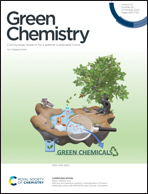Hydrophobic amine-based binary mixtures of active pharmaceutical and food grade ingredients: characterization and application in indium extraction from aqueous hydrochloric acid media†
Abstract
The wide spread use of hazardous and expensive solvents for the liquid–liquid extraction (LLE) of critical metals has been a growing source of waste in the metal refinement industry. We have developed and characterized room temperature liquid hydrophobic binary mixtures based on common pharmaceutical and food grade compounds as sustainable, cost effective alternatives to both ionic liquids and conventional solvents. Additionally, we introduce liquid mixtures with Proton Sponge® (1,8-bis(dimethylamino)naphthalene), one of the strongest known organic bases. These mixtures have been applied to the LLE of indium(III) ions from hydrochloric acid solutions, displaying an extraction efficiency greater than 99% in some systems. A systematic approach to identifying the underlying mechanism of extraction, in particular relating to the charge, solubility, and complexation of the indium species in the organic phase has been developed.



 Please wait while we load your content...
Please wait while we load your content...
